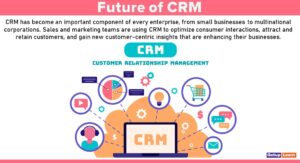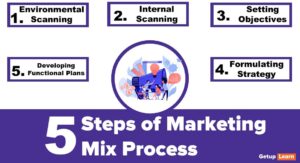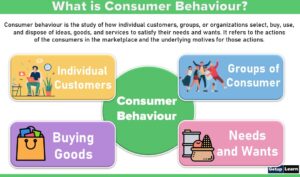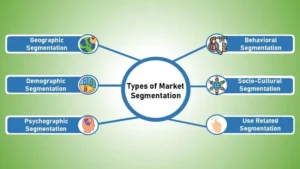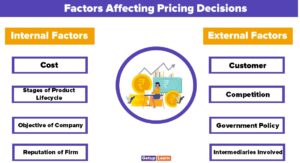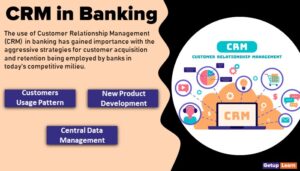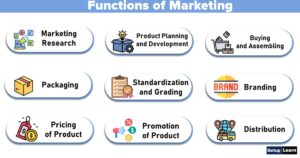Table of Contents
What is Marketing?
Marketing is the process of discovering and translating consumer needs and wants into product and service specifications, creating demand for these products and services and then in turn expanding this demand.
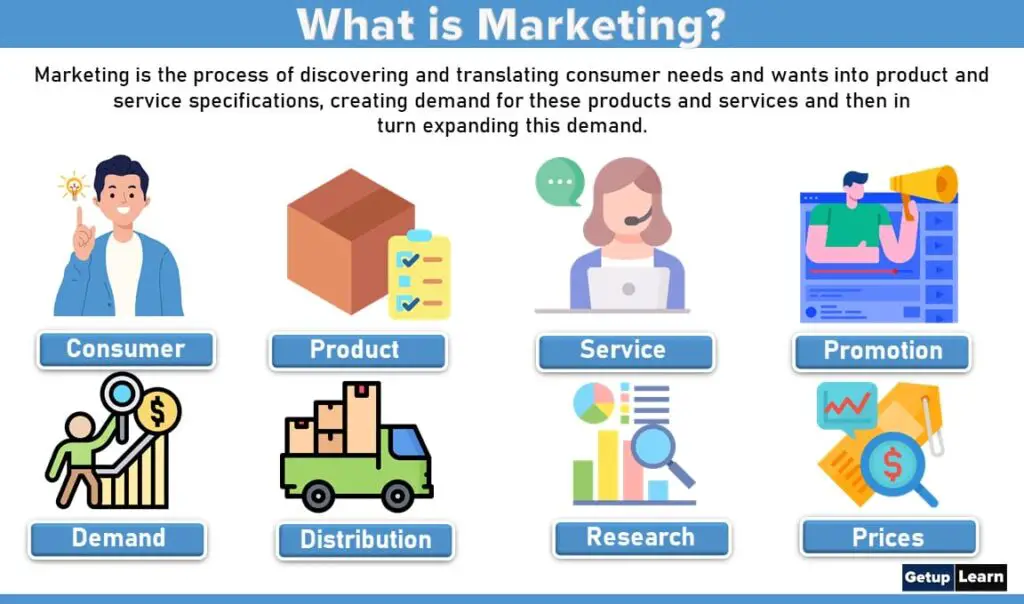
Meaning of Marketing
In other words, Marketing is a process by which goods and services are exchanged and their values are determined in monetary terms as to price. Simply stated, marketing is the activity the manufacturers deliberately undertake and by which they first try to understand the consumer needs and wants and then produce and supply the products for some amount of money.
Marketing is the process of communicating the value of a product or service to customers, for the purpose of selling the product or service. It is a critical business function for attracting customers. From a community point of view, marketing is the link between a society’s material requirements and its economic pattern of response. Marketing satisfies these needs and wants through exchange processes and building long-term relationships.
It is the process of communicating the value of a product or service through positioning to customers. Marketing can be looked at as an organizational function and a set of processes for creating, delivering, and communicating value to customers, and managing customer relationships in ways that also benefit the organization and its shareholders.
Marketing is the science of choosing target markets through market analysis and market segmentation, as well as understanding consumer buying behavior and providing superior customer value. There are five competing concepts under which organizations can choose to operate their business; the production concept, the product concept, the selling concept, the marketing concept, and the holistic marketing concept.
The four components of holistic marketing are relationship marketing, internal marketing, integrated marketing, and socially responsive marketing.
The set of engagements necessary for successful marketing management includes capturing marketing insights, connecting with customers, building strong brands, shaping the market offerings, delivering and communicating value, creating long-term growth, and developing marketing strategies and plans.
Definition of Marketing
These are some definitions of marketing by authors:
Marketing is defined as “a social and managerial process by which individual and groups obtain what they need and want through creating and exchanging products and value with other
Philip Kotler
Marketing defines as “the performance of business activities that direct the flow of goods and services from producers to customer or user.
American Marketing Association
Marketing is the term used to describe collectively those business functions most directly concerned with the demand stimulating and demand–fulfilling activities of the business enterprise
Cundiff and Still
The process of ascertaining consumer needs, converting hem into products or services and then moving the products or services of final consumer or user to satisfy such needs and wants of specific sonsumer segment or segment with emphasis on profitability ensuring the optimum useof the services available to the organisation.
Prof. R.S.Davar
Marketing is any contact that your business has with anyone who isn’t a part of your business. Marketing is also the truth made fascinating. Marketing is the art of getting people to change their minds. Marketing is an opportunity for you to earn profits with your business, a chance to cooperate with other businesses in your community or your industry and a process of building lasting relationships.
Jay Conrad Levinson
Concepts of Marketing
These are the concepts of marketing explained below:
- Need, Want and Demand
- Product and Value Proposition
- Value and satisfaction
- Customer Satisfaction
- Exchanges and Transactions
- Relationships and Networks
- Market
- Marketing Channels
- Segmentation, Target market and Positioning
- Supply Chain
- Competition

Need, Want and Demand
The successful marketer will try to understand the target market’s needs, wants, and demands.
Needs
The most basic concept of marketing is human needs. Human needs are states of felt deprivation. Human needs can be physical needs (Hunger, thirst, shelter, etc) social needs (belongingness and affection), and individual needs (knowledge and self-expression).
There are five types of needs:
- Stated need (Minimum price)
- Real need (Psychological price)
- Unstated need (Service for post-purchase)
- Delighted need (Supplementary-Gift)
- Secret need (Show up, gesture).
Wants
Wants are the form of human needs shaped by culture and individual personality. Needs become wants when they are directed to specific objects that might satisfy the need. For example, An American needs food but wants a hamburger, French fries, and soft drinks but a British wants to fish, chicken, chips and soft drinks. So, it differs.
Demands
Wants become demand when backed by purchasing power. Consumers view products as bundles of benefits and choose products that add up to the most satisfaction. Demand comprises three steps first, desire to acquire something, second, willingness to pay for it, and third, ability to pay for it. Many people want a Mercedes; only a few are able and willing to buy one.
Companies must measure not only how many people want their product, but also how many would actually be willing and able to buy it. However, marketers do not create needs; Needs preexist marketers. Marketers, along with other societal influences, influence wants. Marketers might promote the idea that a Mercedes would satisfy a person’s need for social status. They do not, however, create the need for social status.
Product and Value Proposition
People satisfy their needs and want with products. A product is any offering that can satisfy a need or want, such as one of the 10 basic offerings of goods, services, experiences, events, persons, places, properties, organizations, information, and ideas. By offering, customers get the value proposition to use or consume the delivered product or services.
So Value proposition is the set of benefits or values it promises to deliver to customers to satisfy their needs. It is actually the answer to the customer’s question: ‘Why should I buy your product?
Value and satisfaction
Value is the consumer’s estimate of the product’s overall capacity to satisfy his or her need. Every product is associated with value, cost, and satisfaction. For example, if one is to choose between a fan and air conditioners, all these three factors are taken into account.
Value can be defined as a ratio between what the customers get and what they give in return. The customers get the benefit and assume costs. Value = Benefits / Costs. Marketers’ concern should be to raise the value in the minds of the customers. When the value of the products or services is high, customers are willing to pay more for the products. Thus;
Value= Functional Benefit+ Emotional Benefit/Monetary costs +Time costs + Energy costs +Psychic costs
Customer Satisfaction
Customer satisfaction is the extent to which a product’s perceived performance matches a buyer’s expectation. If performance matches the expectation level, the customer becomes satisfied but if the product’s performance falls short of expectations, the customer will be dissatisfied. If performance exceeds expectations, the customer will be highly satisfied or delighted.
Exchanges and Transactions
Exchange
Marketing occurs when people decide to satisfy needs and wants through exchange. Exchange is defined as the act of obtaining a desired object from someone by offering something in return. For exchange potential to exist, five conditions must be satisfied:
There are at least two parties:
- Each party has something that might be of value to the other party.
- Each party is capable of communication and delivery.
- Each party is free to accept or reject the exchange offer.
- Each party believes it is appropriate or desirable to deal with the other party.
Transaction
If an exchange is the core concept of marketing, the transaction is the marketing’s unit of measurement. Two parties are engaged in exchange if they are negotiating- trying to arrive at mutually agreeable terms. When an agreement is reached, we say the transaction takes place. Thus, a transaction is a trade of values between two or more parties. When the exchange is made, it results in a transaction. A transaction involves several dimensions:
- At least two things of value
- Agreed-upon conditions
- A time of agreement
- A place of agreement.
Relationships and Networks
Transaction marketing is part of a larger idea called relationship marketing. Relationship marketing aims to build long-term mutually satisfying relations with key parties customers, suppliers, and distributors in order to earn and retain their long-term preferences and business. Effective marketers accomplish this by promising and delivering high-quality products and services at fair prices to the other parties over time.
Relationship marketing builds strong economic, technical, and social ties among the parties. It cuts down on transaction costs and time. The ultimate outcome of relationship marketing is the building of a unique company asset called a marketing network.
A marketing network consists of the company and its supporting stakeholders (customers, employees, suppliers, distributors, university scientists, and others) with whom it has built mutually profitable business relationships.
Market
From the viewpoint of modern marketing, the market doesn’t stand for a place where buyers and sellers gathered to buy or sell goods. A market is the set of actual and potential buyers. More specifically, a market is an arrangement of all customers who have needs that may be fulfilled by an organization’s offerings.
The size of a market depends on the number of people who exhibit the need, have resources to engage in exchange, and are willing to offer these resources in exchange for what they want. The key customer markets can be the Consumer market, Business Market, Global Market, and Non-profit and Government market. Now marketers view the sellers as the industry and the buyers as the market.
The sellers send goods and services and communications (ads, direct mail, e-mail messages) to the market; in return, they receive money and information (attitudes, sales data). The inner loop in the diagram in Figure 1-1 shows an exchange of money for goods and services; the outer loop shows an exchange of information.
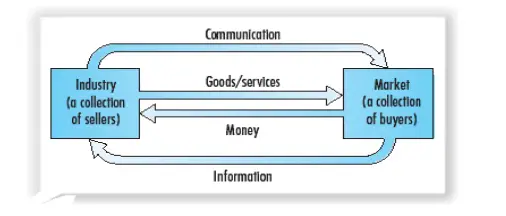
Marketing Channels
Marketing channels means the parties that help the company to promote, sell and distribute its goods to final buyers. To reach a target market, the marketer uses three kinds of marketing channels:
-
Communication Channels: deliver and receive messages from target buyers and include newspapers, magazines, radio, television, mail, telephone, and the internet.
-
Distribution Channels: The marketers use this channel to display, sell or deliver the physical products or services to the buyer or user. They include distributors, wholesalers, retailers, and agents.
- Service Channels: The marketer also uses service channels to carry out transactions with potential buyers. Service channels include warehouses, transportation companies, banks, and insurance companies that facilitate transactions.
Segmentation, Target market and Positioning
Market Segmentation means dividing a market into smaller groups of buyers on the basis of different needs, characteristics, or behavior. Market segments can be identified by examining geographic, demographic, psychographic, and behavioral differences.
The marketer then decides which segments present the greatest opportunity which is its target market. For each chosen target market, the firm develops a market offering. The offering is positioned in the minds of the target buyers as delivering some central benefits.
Thus, product positioning is the way a product occupies a place in the minds of the customers relative to competing products. Like, Volvo, positions its car as the safest a customer can buy, whereas Ford positions on the economy and Mercedes and Cadillac positioned on Luxury.
Supply Chain
A supply chain is a channel stretching from raw materials to components to final products that are carried to final buyers. The supply chain of women’s purses starts with hides and moves through tanning, cutting, manufacturing, and marketing channels to bring products to final customers.
This supply chain represents a value delivery system. Each company captures only a certain percentage of the total value generated by the supply chain. When a company acquires competitors or moves upstream or downstream, its aim is to capture a higher percentage of supply chain value.
Competition
The competition includes all the actual and potential rival offerings and substitutes a buyer might consider. There are several possible levels of competition:
-
Brand Competition: A company sees its competitors as other companies that offer similar products and services to the same customers at similar prices. Volkswagen might see its major competitor as Toyota, Honda, and other manufacturers of medium-period automobiles. It would not see itself competing with Mercedes or Hyundai.
-
Industry Competition: A company sees its competitors as all companies that make the same product or class of products. Volkswagen would see itself competing against all other automobile manufacturers.
-
Form Competition: A company sees its competitors as all companies that manufacture products that supply the same service. Volkswagen might see itself as competing against not only other automobiles but also against manufacturers of motorcycles, bicycles, and trucks.
- Generic Competition: A company sees its competitors as all companies that compete for the same consumer dollars. Volkswagen might see itself competing with companies that sell major consumer durables, foreign vacations, and new homes as substitutes for spending on a Volkswagen.
Scope of Marketing
Now a day, marketing offers are not confined to products and services. The scope of marketing is now becoming larger. Marketing people are involved in marketing several types of entities:

Goods
Physical goods constitute the bulk of most countries’ production and marketing efforts. Most of the country produces and markets various types of physical goods, from eggs to steel to hair dryers. In developing nations, goods particularly food, commodities, clothing, and housing are the mainstay of the economy.
Services
As economies advance, a growing proportion of their activities are focused on the production of services. The Indian economy today consists of a 70–30 services-to-goods mix. Services include airlines, hotels, maintenance and repair people, as well as professionals such as accountants, lawyers, engineers, and doctors. Many market offerings consist of a variable mix of goods and services.
Experiences
By orchestrating several services and goods, one can create, stage, and market experiences. Walt Disney World’s Magic Kingdom is an experience.
Event
Marketers promote time-based events, such as the Olympics, trade shows, sports events, and artistic performances.
Persons
Celebrity marketing has become a major business. Artists, musicians, CEOs, physicians, high-profile lawyers and financiers, and other professionals draw help from celebrity marketers.
Place
Cities, states, regions, and nations compete to attract tourists, factories, company headquarters, and new residents. Place marketers include economic development specialists, real estate agents, commercial banks, local business associations, and advertising and public relations agencies.
Properties
Properties are intangible rights of ownership of either real property (real estate) or financial property (stocks and bonds). Properties are bought and sold, and this occasions a marketing effort by real estate agents (for real estate) and investment companies and banks (for securities).
Organizations
Organizations actively work to build a strong, favorable image in the mind of their public. Philips, the Dutch electronics company, advertises with the tagline, “Let’s Make Things Better.” The Body Shop and Ben & Jerry’s also gain attention by promoting social causes. Universities, museums, and performing arts organizations boost their public images to compete more successfully for audiences and funds.
Information
The production, packaging, and distribution of information is one of society’s major industries. Among the marketers of information are schools and universities; publishers of encyclopedias, nonfiction books, and specialized magazines; makers of CDs; and Internet Web sites.
Ideas
Every market offering has a basic idea at its core. In essence, products and services are platforms for delivering some idea or benefit to satisfy a core need.
Importance of Marketing
The success or failure of any organization, profit-making or otherwise depends on marketing. As the economy progresses, the importance of marketing also increases. With the progress of the economy, the demand and supply of certain new products and services start increasing and some of the existing products or services start losing their demands.
Below we will discuss the importance of marketing from society’s point of view:
- Marketing Improves Standard of Living
- Marketing Connects Producers and Consumers
- Provides Employment Opportunities
- Helps to Provide Economic Stability
- Helps to Utilize Our Natural Resources
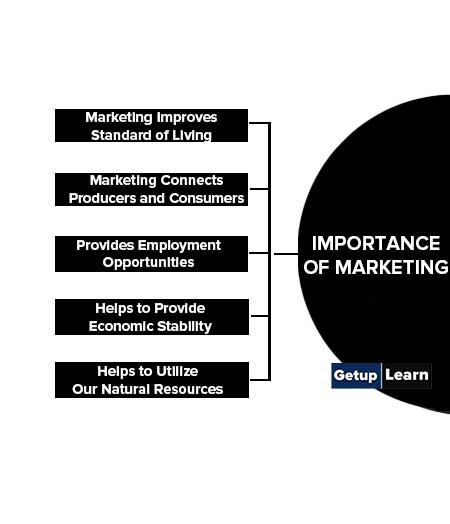
Marketing Improves Standard of Living
Marketing promotes large-scale production and sales which bring down the cost of production and increases the amount of profit. Lower price results in large consumption by a large number of consumers which improves the standard of living at large.
Marketing Connects Producers and Consumers
The producers produce goods and services for the purpose of selling. Therefore, the producers should be in touch with the consumers who require such goods and services. In the absence of a marketing process, it would have been extremely difficult for producers to find out what customers want.
Provides Employment Opportunities
Marketing results in large-scale production which in turn creates a good number of employees in the production process. Thousands of people are employed to manage the retail and wholesale establishments.
Helps to Provide Economic Stability
A good marketing system enables maintaining the price level stable by matching the demand and supply at various places and different periods. This is possible by creating time and place utility.
Helps to Utilize Our Natural Resources
It is marketing that collects the needs, wants, desires, preferences, etc. of domestic consumers and international consumers and analyzes the information to produce goods and services for better satisfaction of consumers. In the process of producing various goods, they are utilizing the national resources up to the optimum level.
Importance of marketing from producers/firms’ point of view:
- Marketing creates awareness among potential consumers and motivates people to purchase the products and services to satisfy their needs and wants. In this process, the firms generate revenue by selling the goods and services with which the firms further produce and grow.
- The marketing organization provides a channel of communication between the firm and the consumers. It is furnishing information about the consumers’ demands, tastes, and preferences to the top management. This process helps the firm to adjust its production schedule to suit the tastes of the consumers.
- It helps the producers to increase the volume of sales which forces large-scale production and results in more profit.
From the above explanation, you will be able to realize the importance of marketing in the economic development of a country.
What is the meaning of marketing?
In Simple words: Marketing is a process by which goods and services are exchanged and their values are determined in monetary terms as to price. Simply stated, marketing is the activity the manufacturers deliberately undertake and by which they first try to understand the consumer needs and wants and then produce and supply the products for some amount of money.
What is the definition of marketing?
Marketing defines as “the performance of business activities that direct the flow of goods and services from producers to customers or users. By American Marketing Association
What are the concepts of marketing?
Following are the concepts of marketing:
1. Need, Want and Demand
2. Product and Value Proposition
3. Value and satisfaction
4. Customer Satisfaction
5. Exchanges and Transactions
6. Relationships and Networks
7. Market
8. Marketing Channels
9. Segmentation, Target market, and Positioning
10. Supply Chain
11. Competition.
What is the scope of marketing?
Following is the scope of marketing:
1. Goods
2. Services
3. Experiences
4. Event
5. Persons
6. Place
7. Properties
8. Organizations
9. Information
10. Ideas.
What are the importance of marketing?
Following are the importance of marketing given below:
1. Marketing Improves Standard of Living
2. Marketing Connects Producers and Consumers
3. Provides Employment Opportunities
4. Helps to Provide Economic Stability
5. Helps to Utilize Our Natural Resources.


